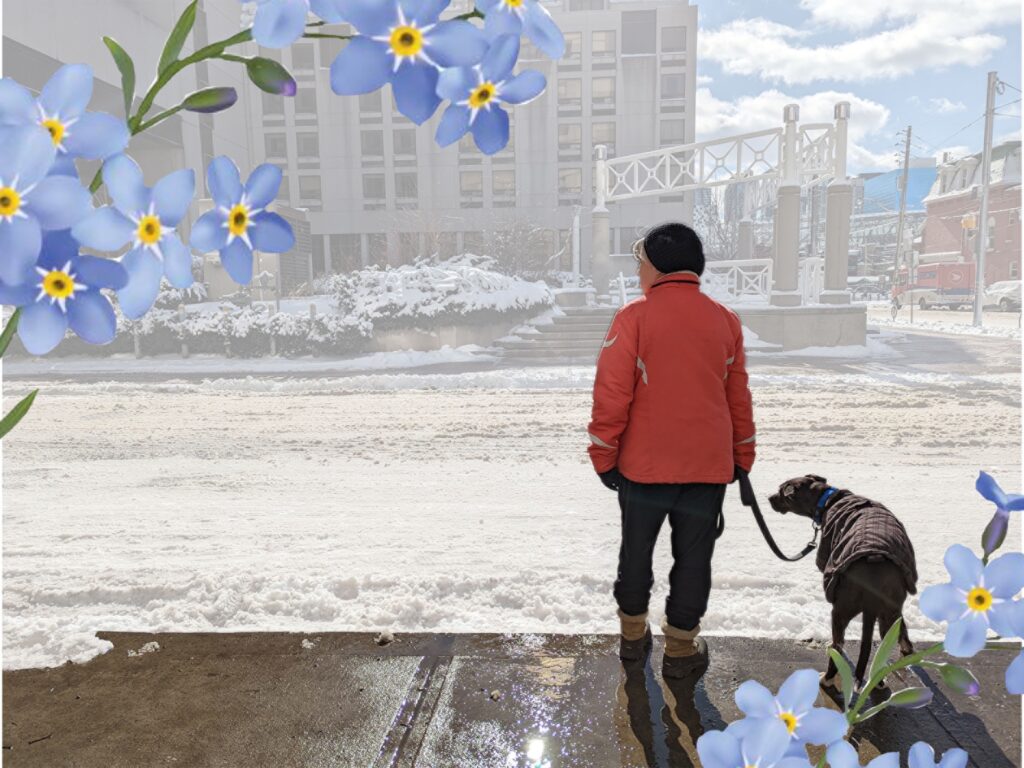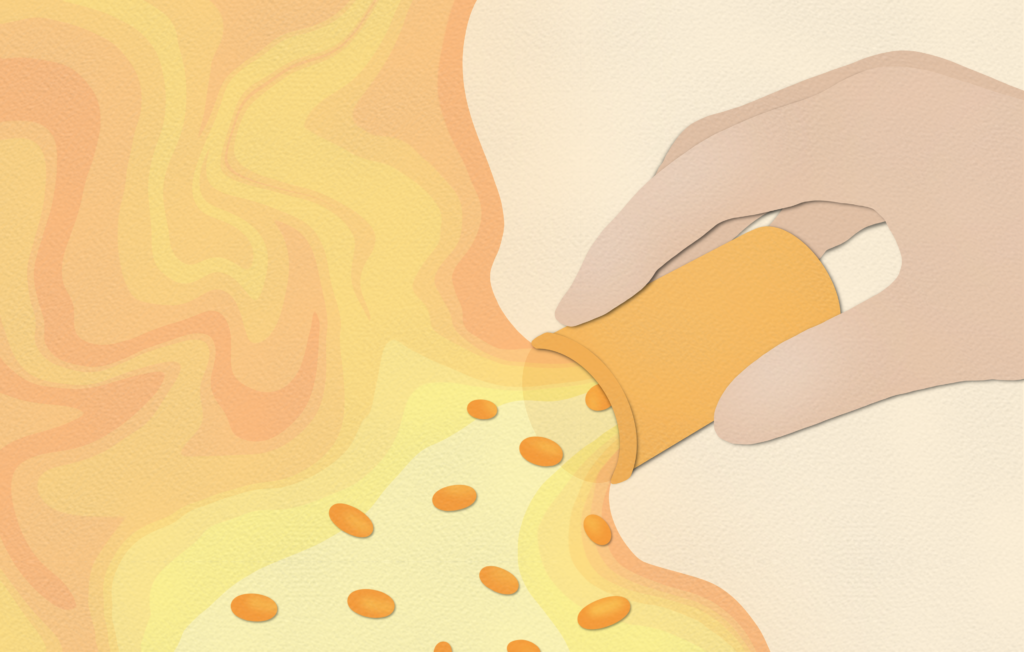How navigating mom’s memory loss highlights the gaps in Ontario’s older adult care
BY BRIT WEAVER
ART BY CHIARA GRECO
———————————————————–
Lost
“I don’t know where I am, the city looks so different. I just want to go home.”
Jean’s voice is shaky over the phone. My mom is the eldest sibling of six, and a tough five-foot-two woman who grew up as a working-class, mixed-race kid in downtown Toronto. Her admission tells me this is more than getting lost in the dark. It’s Christmas Eve 2020, and by 4 p.m. the temperature drops and rain starts to shift to snow. The sun’s going down and darkness creeps in. I’m nervous because we moved to a new apartment in Toronto and I’m not sure mom—driving from Oshawa, an hour east of the city—will find it.
An hour later, I get a call. Mom is at the corner of Queen and McCaul streets in downtown Toronto. She knows that part of the city well, having grown up there in the 1960s and then starting a family there 20 years later. She asks me for directions, and I encourage her to use her smartphone.
Twenty minutes later, still no sign of her. Traffic must be bad, but then again, it’s Christmas Eve. Another 20 minutes pass. I look out the window like a puppy in a pet shop. So, I call her. She’s driving up Islington Avenue in Etobicoke, a 20-minute drive west of our apartment. I tell her she needs to turn around and go back. She’s frazzled, disoriented, afraid. I can recall only a couple of times she has sounded helpless—once when she found my lost dog dead, another time when she called to say my dad died. Those times crushed me, not because of the tragedy, but because a woman that tough had crumbled.
Twenty minutes later there is still no sign of her, so I call again. “I just don’t know where I am,” she tells me. “The city looks so different.”
Again.
I tell mom to pull over, put on the emergency lights. What’s the closest intersection? She says Fleeceline Road and Lakeshore Boulevard—a thirteen-minute drive away. As a city dweller, I don’t have a vehicle, but I am a member of an auto-share service, an app that allows you to rent a car by the minute, hour, or day. I book the closest one to our apartment, a ten-minute walk.
This is ridiculous, I think. It’s been hours since she left. My partner, Kevin, and I bundle up in our winter gear and walk to the car. On the way, I get another call from mom. Where is she now?
She tells me she doesn’t know where she is and how the city looks so different.
Again.
I ask her where she is.
Again.
She tells me she’s at Fleeceline Road and Lakeshore Boulevard.
Again.
Oddly, I’m calm. Robotic.
My partner and I get into the compact car and drive to the intersection. Through the dark and the snow flurries we see orange lights blinking from a silver SUV—yes, her SUV!—at the corner.
When we get back to the apartment, we settle mom in the living room and put on the TV, her favourite pastime. We ditch the rental, and take her car to an underground parking garage not far from the apartment. We have stew for dinner and go about our Christmas Eve as planned. There is no mention of her getting lost or what that means.
After dinner we sip a couple of cocktails while watching Love, Actually, a holiday tradition in my family. Mom has a glass of red wine and, in between roars of laughter, keeps asking where she parked the car and whether she turned off the lights.
Our Older Adults
As the population ages, more older adults will require care in Ontario, adding pressure to an already stressed healthcare system. Increasingly complex medical needs—and a lack of primary and home care options—already affect our hospitals. The province’s limited hospital beds are sometimes used for patients who, if given adequate resources, could manage their conditions at home.
In 2022, the Ontario Provincial government attempted to remedy this by adding Bill 7, More Beds, Better Care, which amended the Fixing Long-Term Care Act, enacted the year prior. The newly passed amendment is an attempt to alleviate the strain on hospitals by allowing physicians to recommend elderly patients be sent to long-term care units up to 70 kilometers away in southern Ontario or up to 150 kilometers away in the two northern Ontario districts. Those who refuse to leave the hospital could be charged up to $400 per day. The new amendment is divisive. Critics worry that, in practice, older adults will be forced to receive care far away from their communities. Others working in acute care express an urgent need to free up these beds. We need to find new solutions.
Luckily, with my mom, we’re not there yet. She forgets a lot of things, but isn’t in need of constant professional medical care, like incontinence support or physical feeding. Dr. K. Jennifer Ingram, the founder and medical director of the Kawartha Centre – Redefining Healthy Aging (a specialist medical and research facility), says that there is a “non-system of care” for those living with dementia. Dr. Ingram has been working as a geriatrician since the 1980s and has been fighting for more services and training in dementia care ever since. She’s direct, knowledgeable and exudes a strength born of decades of advocacy work. As part of her role as a clinician, she helps families and patients problem-solve and understand how to live fully and live with dementia in a way that best supports their autonomy. Through the Kawartha Centre, she also assists community agencies, hospitals, and other healthcare professionals develop dementia-savvy programs that will serve people better than current offerings.

“A proud patient like my mother… could present to a care coordinator like there’s nothing wrong at all.”
The Ministry of Health and the Ministry of Long-Term Care are the guiding forces behind older adult care in the province. When contacted about the state of older adult care in the province, the ministries outlined that they have invested $4.5 billion for home and community care in 2021–22. This has been spent on hiring, training, and incentivizing nurses, a tax credit for upgrading home safety and accessibility equipment, and more hospital beds.
My mom is 70 years old, young for someone who forgets a lot and can no longer drive. Normally, she would be living her golden years in blissful retirement. However, she no longer remembers to sleep, to eat, whether she walked the dog, or if she saw a family member that morning. She can’t operate a laundry machine or remember how to write a cheque. In a perfect world, when an adult reaches this stage, they would choose one of three avenues: a retirement home, home care, or long-term care. Unfortunately, this isn’t how it went in my mom’s case.
Retirement homes provide care for older adults—but it’s privately owned, out of pocket, and expensive, so that’s off the table. Provincially funded home care covers certain aspects of aging, and helps with services like health, personal care, and homemaking. Long-term care is where one goes when home care is no longer meeting their needs. At the time of her assessment, mom didn’t qualify for the bulk of these services.
While the province guarantees home or long-term care to those who need it, a patient must undergo an assessment through the Home and Community Care Support Services (HCCSS) to see if they qualify, and are the best candidate for the available care. (Until April 2021, the HCCSS was called the Local Health Integration Network, or LHIN).
When asked why my mom didn’t qualify for long-term care, the HCCSS told me in an email that being a risk to oneself is not used to assess a patient’s eligibility. They said anyone can receive home care. For long-term care, they referred me to their website which states that anyone who is 18 years of age or older, has a valid health card, and cannot meet their healthcare needs at home, is eligible.
After an assessment, my mom, who can’t cook for herself, can’t remember to eat, and doesn’t know when she last saw us, was not deemed eligible by HCCSS for these care options, with the exception of Meals-on-Wheels once a day.
During an HCCSS assessment, a care coordinator will assess a patient’s health, and may additionally perform a capacity assessment, functional assessment or behavioural assessment of the patient. With my mom, the coordinator asked questions about her daily life and who takes care of the regular affairs. But if a patient is living with a cognitive impairment or dementia, when the coordinator asks who pays the bills, buys groceries, cooks, or does the laundry, the candidate could very well believe they do it all.
The test misses the nuanced experience of someone living with dementia. A proud patient like my mother, used to being in charge and hilariously self-deprecating, could present to a care coordinator like there’s nothing wrong at all.
To receive important aspects of home care, like nursing support, or to qualify for long-term care, a patient must need physical assistance or require constant supervision for their own safety. If mom had been burning items or wandering the streets, and if these instances had been documented by authorities, or if physical ailments were addressed through visits to the emergency room, she may have been eligible. This is how the system works. “It’s making the patient a pawn in a non-system of care,” says Dr. Ingram. “It is a game that you have to learn as a family. How to work it, how to work it when it doesn’t work for you, how to state your problem in a way so that they register it, how to escalate your problem when nobody’s listening.”
What all this means is that there’s a widening gap in the accessibility of care for low- and middle-income families with someone who requires extra support. If an older adult and their family don’t have the means for a general retirement home or paid extra care—tough luck. Instead, families are left in precarious situations, leading double lives in order to support their loved ones by checking in daily, managing their finances, cleaning, cooking, shopping, and doing laundry, among other activities. To get additional professional support, families like mine have to wait for a severe burn to happen, for a call about their loved one wandering the streets, or until they are incontinent or terminal.
In short, if families don’t have disposable income, they experience a separate tier of older adult care.
A Long Time Crumbling
Older adult care in Ontario is made up of a smattering of organizations and interest groups, with the HCCSS as a central administration system. On paper, the various organizations involved are comprehensive—it seems like there’s something for everyone. In reality it’s a cluster of chaos that is extremely difficult to navigate. Definitive answers are rare. The process of tests, appointments, and follow-ups is reliant on planning, organization, and physical access—activities that become more and more difficult for someone living with cognitive difficulties. It’s dizzying.
Home care and long-term care already had bad reputations in Ontario, but they became worse during the COVID-19 pandemic. The province’s COVID-19 advisory board found that long-term care residents suffered some of the pandemic’s most devastating impacts, including a disproportionately high amount of deaths, due to critical gaps in care. Even before that, a study by the Ontario Health Coalition found that long-term care homes in Ontario were severely under-funded and under-staffed.
They also have notoriously long wait-times. The waitlist for a long-term care bed in Ontario, says Dr. Ingram, is three to five years and it’s going to get worse with the aging population of Baby Boomers. The Ontario Long-Term Care Association says that long-term care homes provide care and support for 115,000 Ontarians and the province, in its 2022 budget, says it has invested a “historic” $6.4 billion since spring 2019. This investment means it’s on track to add 30,000 new beds and upgrade 28,000 existing long-term care beds by 2028.
However, there is evidence that these actions are still insufficient. In 2021, the Financial Accountability Office of Ontario (FAO) estimated that the wait list for long-term care will continue to increase, reaching a length of over 36,000 people by 2024. The FAO also projected that the number of long-term care beds per 1,000 Ontario residents over 75 will continue to drop, from 73 beds in 2018–19 to 66 in 2029–30. There will still not be enough beds for the projected population of aging adults.
And those are for older adults who are eligible to be on the waitlist.
The Realization
Right after Christmas, in January 2021, I visit mom in Oshawa and notice her fridge is empty. There’s no food for her dog, Bella. After much protest from mom, I log into her bank account and find a daunting history of overspending from the last few years. Other than a small retirement fund, she’s broke. Mom’s been living in overdraft since November. She racked up a loan and maxed a credit card, but at least she still has one asset left—her condo.
I buy her groceries and dog food for months but can’t continue indefinitely. With a heavy heart, I tell her that she’ll have to sell her condo to pay off her debts. Maybe we could find a place to live together? That’s a tough pill for me to swallow. As mom always says, it is what it is.
In March, only a few weeks after we spoke about selling her place, mom suddenly puts her condo on the market. It’s sold within 10 days. The new owners will take possession mid-April.
Frustrated, I ask her:
What about finding a place to live together?
She doesn’t know what I’m talking about.
No way, she says. I like living on my own.
The scramble to find housing in Toronto begins. Later that month, on a cold and cloudy day, mom’s youngest sister, Pearl, randomly gets a call from mom. She said an apartment viewing was cancelled and she was on her way to Pearl’s place, but couldn’t remember how to get there. Pearl has lived in the same neighbourhood for decades. My aunt made a series of phone calls to local apartment complexes and got a couple of viewings. Since mom didn’t have any money until the cheque came through on the sale of the condo, Pearl, like a practical earth angel, was able to act as a financial support and guarantor.
Despite all the changes, Pearl says that Jean didn’t seem bothered. She was just going through the motions.
“We noticed small things with mom’s memory years ago, but figured she was reshaping her narrative to cope with a lifetime of loss.”

After weeks of filing paperwork, driving mom to the lawyers, packing up her condo, and getting Kevin to help me with three trucks’ worth of junk removal, I call mom’s family doctor to request an appointment at the memory clinic. The wait time is three months.
Around June, I call the family doctor to see where we are on the list. It’s been three months and she has moved up, but the memory clinic had redirected its efforts to the mass immunization effort against COVID-19. I was told that she is high enough on the list that by August or September, when the clinic resumes, she will get an appointment.
September 2021, as I am entering my first term of an intense graduate program, I get a call from the memory clinic to say mom has an appointment at the end of the month. This would be the beginning of a battery of tests. Not yet the tests that would deem her ineligible for most home care. These would determine what was happening with her mind.
Que Sera Sera
When I describe my mom, I always start with how funny she is. She has this magical power, almost witchlike, of brushing off tragedy with a hearty laugh. Mom lived quite a life, and it gave her what many refer to as “resilience.” We noticed small things with mom’s memory years ago, but figured she was reshaping her narrative to cope with a lifetime of loss.
Mom was born in 1952 in Sudbury, Ontario, to a Canadian woman, Alice—a young mother with a predilection for parties—and a Chinese man, Deep, who came over just before the Chinese Exclusion Act. Shortly after her birth, they moved to Toronto and my uncle was born.
Soon, Alice found herself deep in the 1950s Toronto party scene and pregnant again. Mary Lou didn’t look like my mom or my uncle, but Deep agreed to give her his last name to prevent Alice from resorting to self-abortion. Mary Lou was raised at her maternal grandmother’s house.
With Alice out during the nights and Deep working during the day, Mom said she was four or five years old when she started taking care of her siblings. She was fiercely protective of them, fending off bullies—kids were afraid of her. Sometimes she still calls herself “mean Jean.”
After a couple of years, Alice was a victim of domestic violence from a boyfriend at the time (not my grandfather). She was paralyzed in a coma in the hospital and died a couple of years later. Mom was twelve years old.
Deep remarried a woman from Hong Kong and had two more children, the youngest being my aunt Pearl. Mom didn’t get along with her new stepmom, so she moved out as soon as she graduated from college and got a job. Once Mary Lou was a little older, they moved into an apartment together on Wellesley Street. Mom was a social worker while Mary Lou worked nights. They would eat dinner together (though it was Mary Lou’s breakfast) and catch up, as sisters do.
Mom got home from work one day and noticed that Mary Lou hadn’t woken up yet. She went in and touched her leg; it was stiff and cold. She called her dad and the police—but in the end, she never wanted to know exactly what had happened. Pearl remembers their dad saying something about a brain aneurysm.
Sometime around 1980, mom went over to a friend’s place and met their new basement tenant, Mark. He was a shy, young (too young, according to her friends) college guy—originally from England, but he didn’t have an accent anymore. Somehow, Mark, highly intellectual and a bit of a math whiz, and Jean, street smart and keeper of her own damn mind, got along famously. They both liked Star Wars and food and understood what it meant to be poor. Eventually, they decided to move in together, start a family, and get married.
In 2012, after a tumultuous three decades of moving around, raising two girls, and the old-age death of Deep in the late 1980s, they settled in Oshawa. Soon after moving there, Dad was diagnosed with terminal cancer and it was around this time that other family members and I noticed things falling apart with mom. We figured the weight of her world was heavy.
Around this time, I started dating Kevin, who met my parents in March 2014. While watching a movie, mom told Kevin, who is Irish, of her travels in Ireland during the 1970s. She told the story at least three times. I shamelessly apologized, saying mom must have been excited or nervous or both.
My dad died in 2015, a week before my parents’ thirty-third wedding anniversary. Mom was crushed. She told me once that her chest kept hurting and she didn’t understand why. I told her that was what a broken heart felt like.
Then mom started exhibiting signs of disorientation and erratic behaviour. She would have trouble remembering how to merge on and off the highway, or she would accelerate until the car started shaking. We put it down to depression, but mom was tough, so tough.
By the end of 2017, Kevin and I moved to Ireland and things with mom got worse. She would arrive three hours early to pick us up from the airport and we’d spend another hour looking for her car in the parking lot. Once, she completely forgot that we were coming home for a visit and didn’t pick us up at all. It was infuriating. I thought she didn’t care or was being reckless.
Whenever I describe my mom, I note how she can pick things up so quickly, how she’s defiant and has a good sense of humour. It’s how she coped with the tough stuff. Que sera sera, she would sing whenever something got us down.
Taken together, these qualities make mom an incredible person—but an awful candidate to diagnose with something like dementia.
Testing, Testing
It’s a sunny morning in late September 2021, a perfect day for the hour drive to the memory clinic. Mom impulsively sold her silver SUV the week before, so we borrow my cousin’s car. When we arrive at the clinic for her 8 a.m. appointment, we are told that we will be interviewed separately, then together. I would be asked questions about noticeable differences in mom’s behaviour, and mom would be given something called the Montreal Cognitive Assessment, or the MoCA Test.
The test consists of tasks and questions that help professionals determine cognitive impairments, scored out of 30. The questions assess short-term memory, language, executive functioning—one’s ability to plan, focus, and follow instructions—as well as spatial and situational orientation. The questions seem simple, like “remember these three words,” or “draw this picture.”
Afterward, mom and I were interviewed together. She was asked a series of questions based on my responses about her changes in behaviour. For example, she was asked questions like, “I hear that you recently moved, can you tell me about the experience?” If her answer does not align with my version of events, it might indicate that she is experiencing confabulation, something that happens when someone replaces a memory with something totally different. There is no intention to deceive; the truth is the person simply can’t remember.
The next tests to be done are blood and brain. Since we are already in a medical centre, we go to the clinic where they would draw blood to detect any other causes for memory impairment. They would look for deficiencies, like vitamin B12, among other possible explanations, such as an underactive thyroid or syphilis.
The blood clinic is busy, and people scatter the halls trying to maintain social distancing. Mom is disoriented, wondering why we’re there. She asks if this is a routine check-up. I had given up explaining too much. We’re here to get bloodwork done, I remind her.
She shrugs—it is what it is—and we continue to wait. After almost an hour, they call for mom, and she disappears into the room. Minutes turn into a half hour and she finally emerges. Mom says she was left in a room unattended, where she accepted her fate and did nothing. But with her declining memory it’s hard to know.
Mom is also referred for magnetic resonance imaging, or an MRI, at a Toronto hospital. The MRI would check for possible causes of memory impairment, such as stroke, tumours, vascular changes, and atrophy (a loss of brain cells).
Mom’s final test would be with a geriatric psychiatrist to eliminate any other disorders that may be causing moments of mania or anxiety. The geriatric psychiatrist can also prescribe medication that could lessen the symptoms of dementia.
Dementia is an umbrella term for a set of symptoms that is caused by disorders of the brain. These include Alzheimer’s disease, vascular, frontotemporal, and Lewy body, among many others. Although scientists do not yet know what causes dementia, there are a few identified factors that may increase the chances of developing symptoms, including lifestyle, environment, and genetics.
More than a year after the first call to her family doctor, and after many follow-up calls to specialists, mom was diagnosed with a moderate neurocognitive disorder, the medical term used for the condition that causes symptoms of dementia.
Family Matters
When I spoke to experts, many said that patients living with dementia are better off when they age at home. The surroundings are familiar and it gives the patient a chance to interact with their community for as long as possible. Another common theme was that Ontario’s choice to invest in long-term beds instead of supports for residents to remain at home is all wrong.
Things like adult day programs fill a tremendous gap for seniors’ needs, says Dr. Ingram, and should be available to anyone who is living with dementia. These programs are a more cost effective way to provide support while preventing older adults from moving into long-term care, a retirement home, or worse, the hospital.
John Lord, one of the leaders of a group called Seniors for Social Action Ontario (SSAO), says that current long-term care homes are no place for most people who live with dementia. SSAO extensively advocates for a change in how the system treats older adults—especially those living with dementia. “People want to be where they are comfortable, where they are valued, where they can have family come and visit,” says Lord. “People want to stay in a home-like environment.”
For those living with dementia, being placed in a complex, brand-new setting with so many others is confusing and could potentially do more harm than good. Lord says there are long-term care homes that are smaller, with each house accommodating only four to six residents with a backyard space. This allows them to bond with their housemates and creates a more tranquil environment.
Lord would like to see more of these small-scale homes take root and become integrated into neighbourhoods. This would enable those living with dementia to stay and interact in their regular community. Historically, personal agency is a strong theme in North America, but the reality is we are all interdependent. “That desire to be independent takes away from the ability to ask for help,” he says. “People are really hesitant—they’re cautious, they think they’re going to be a burden.”
Lord continues, “Older people can actually make an incredible contribution. We just have to figure out what that contribution is and how we can support it.”
The utopian idea that Lord puts forth is a revelation to me. I picture mom in a home across the street with a couple of friends, living out her days in comfort and safety. I throw away the idea of long-term care and settle into this new life I’ve imagined for her. And then, like a pin to a stretched-out rubber balloon, reality sets in.
Bed Bugs & Ballyhoo
A year after my mom got lost on the way to christmas dinner, I start noticing little red bites on her. Kevin mentions something about bedbugs. He checks my mom’s couch and finds a dead one. “She definitely has bedbugs.”
So, I tell my mom’s building administration and one of them gives me a list of steps to prepare her unit for a spray. Clean all surfaces. Move all items to a central location, like a table, and make sure it’s all six inches from the walls. Cover with plastic bags. Wash and dry everything—clothes, bed sheets, couch covers—in high heat and bag them. She can keep one bag with a few changes of clothes to wear. Everything else must remain in the bags. The pest controllers will arrive at some unspecified time between 9 a.m. and 5 p.m. Wait six hours after they spray before returning. This process needs to be completed again in two weeks.
I ask the building administration where mom is supposed to wait during the spray. They recommend a coffee shop, maybe. Or my house, maybe.
I say, she has bedbugs! She can’t go to anyone’s house. She also has a dog and can’t go to a coffee shop. It’s December, so she can’t sit in a park all day.
I ask again: Where is she supposed to go?
They don’t know.
My uncle says she can go to his house.
The night before the spray, Kevin and I change into expendable clothes in mom’s bathtub. The chances of there being bedbugs in the bathtub is lower, or so I’m told. We spend four hours that evening cleaning the apartment, washing and bagging, and leaving notes everywhere to remind mom to not unpack the bags. It’s almost midnight. I will text my uncle in the morning.

“She asks us to order her a microwave, even though she’s thrown out two in the last year because they’re ‘old.’”
By early morning, I text him to remind mom, again, to not unpack the bags. It’s too late, he texts back. She’s unpacked most of it.
Two weeks later, my uncle is away visiting friends and, again, mom has nowhere to go for the second bed bug spray. I press the building administration. The best they can do is the party room in the basement, but she must not move from one designated spot on the couch.
Like a proper wash cycle, we repeat the motions. This time, I spent the entire day before cleaning the laundry and apartment. Rebagging everything.
Again.
At 10 a.m. the next day, I get back to mom’s and notice only half the bags are unpacked. Better, I suppose. We leave her place to go to the party room with her dog in tow. I settle her into one spot on the couch, and give her a laptop filled with movies and headphones so I can try to concentrate on my schoolwork. I put on Love, Actually, because it’s getting close to Christmas.
There’s no Wi-Fi, so I stick to writing. While I’m typing, she’s singing off-tune in the background, cut with spurts of cackling laughter. She keeps taking off her headphones to ask where we are and what we’re doing here.
When the movie stops, she starts crying. Maybe it triggered memories of dad. I ask what happened and she says, so lucidly, you have no idea how much I appreciate everything you do.
I hold back tears that sit in my eyes, watching her crumble.
Again.
It’s no problem, but maybe you could stop arguing with me, I poke.
I know she won’t—deep down we both do.
Late in the evening, I start packing up to head back to the apartment. She asks where we are and what we’re doing down there.
Let’s just go, I say.
I’m not going anywhere! I’m in my pajamas!
There she is. There’s the fighter.
It Is What It Is
Recently, mom has been afraid to cook meals. She asks us to order her a microwave, even though she’s thrown out two in the last year because they’re “old.” Often, we find burnt trays and pots soaking in the sink, charred crumbs lining the garbage bin, remnants of meals forgotten on the stove or counter. We perform ritualistic cleanses of her fridge to remove bags of slimy thawed chicken, rancid pork, and fuzzy fruit. My aunt purged her cupboards to find multiple bags of liquified onions and potatoes, a constant result of over-ordering groceries.
There was a stint where mom would spend over $600 on groceries, ordering basics like apples, clementines, soup, bread, and frozen dinners three or four times over. Some days, I would open her fridge and find it bursting with meat on top of fruit and no-longer-frozen burger patties and fish fingers and tubs of ice cream. The freezer was too full. I have since taken over ordering groceries.
Some days, we find cold fried rice congealed in a pan and are told to leave it there, as it’s her dinner (we throw it out anyway). The HCCSS care coordinator connected me with Meals-on-Wheels, a service that provides a daily hot meal for those in need. It has drastically reduced the burn rate. Her day programs resumed after COVID-19–related lockdowns eased. Mom could get out of the house and socialize with other older adults, but she doesn’t want to. After months of poking around, I connected with a homemaking service where, every two weeks, someone comes around to tidy up and do the laundry. For everything else, we’ll have to wait until she deteriorates even more than she already has.
“She constantly tells us to live our lives, but forgets that she is a part of everyone’s life.”

Dr. Ingram’s take on older adult care is that, currently, there’s not enough support for patients and their families. “The whole system of finding help at home is a dog’s breakfast,” she says. “It is an effort that everybody goes through to try and find a helper from wherever they can find them—a church, a school, friends, neighbours. People hire their grandkids and put them on the payroll. They do all sorts of things if they’ve got money. If you don’t have money, it’s a mess.”
Mom has a chunk of money left from selling her condo and paying off her debts. It’s enough to supplement her $1,600 a month pension, even though she pays over $1,500 for rent. It would be enough to get a private room in a long-term care home, if she qualified, but not enough to go to a retirement home that offers dementia care for longer than a few years. Since Mom turned 70 this year, we don’t know how long to plan her finances for, or what we should splurge on, or for how long.
Mom’s bedding has been intact for weeks, a sign that she is napping on the couch in front of the TV. It means she’s not sleeping through the night, a symptom common to dementia. There’s nothing we can really do about that. She knows her memory is off but she’s tough and believes she can handle it. She constantly reminds everyone that she’s fine and doesn’t need us to stop by every day. She doesn’t remember when anyone stops by anyway, or how much help she actually needs. She constantly tells us to live our lives, but forgets that she is a part of everyone’s life. So, for now, we watch for smoke signals, monitor our phones in case she or someone else calls to say she’s lost. We let it happen, and we document it so that we can build a case for more care. Since she is tough and laughing, we are told to do the best we can.





